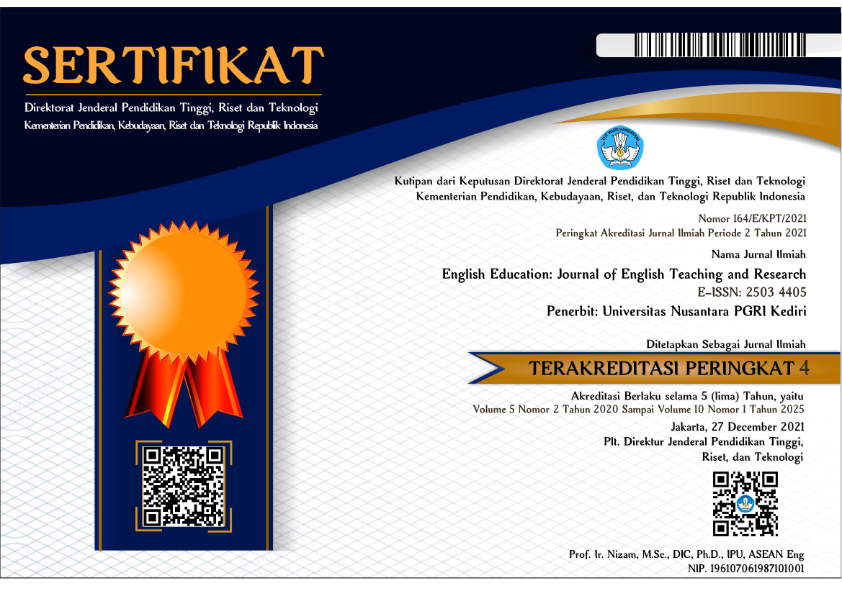Reading - Based Writing Model: A blended learning alternative
DOI:
https://doi.org/10.29407/jetar.v6i2.16992Keywords:
writing, needs, syntax of model, readingAbstract
ABSTRACT
Writing is often regarded as a difficult skill to acquire by majority of EFL learners. Teaching writing is also unquestionably challenging. It is argued that an essential effort to assist learners is having them explore information to write through reading topic and genre- related sources extensively. This article seeks to explain the result of a study employing R&D method to develop a Reading-Based Model to teach academic writing. It will report the results of the needs analysis briefly and then explain the model itself. The data about the students' needs of writing according to the students and the writing lecturers were collected through questionnaire and interview. The results of needs analysis and relevant literature confirmed that reading prior and during writing is elemental. The syntax of the model was developed on the basis of literature dealing with the principles of reading-writing relations and the Genre-based Approach. It consists of 4 main stages. Some activities within each stage can be carried out online. The model has gone through a validation process by two experts (two experienced lecturers teaching writing skills). The model was considered valid by the experts; a few recommendations were concerned with additional activities.
Downloads
References
REFERENCES
Al-Khasawneh, F. (2010). Writing for academic purposes: Problems faced by Arab postgraduate students of the college of business, UUM. ESL World, 9 (2), pp.1-23.
Anggraini, R., Rozimela, Y., & Anwar, D. (2020). The Effects of Collaborative Writing on EFL Learners’ Writing Skills and Their Perception of the Strategy. Journal of Language Teaching and Research, 11 (2), pp. 335-341. DOI: http://dx.doi.org/10.17507/jltr.1102.25.
Bhatia, V. K. (1993). Analysing Genre: Language Use in Professional Settings. London: Longman.
Bruce, I. (2008). Academic Writing and Genre; A Systematic Analysis. London: Continuum
Carter, M., M. Ferzli , & E. Wiebe. (2004). Teaching Genre to English First- Language Adults: A Study of the Laboratory Report. Research in the Teaching of English, 38 (4), pp. 395- 419.
Challagan, M., Rothery, J. (1988). Teaching Factual Writing: Report of the Disadvantaged Schools Program Literacy Project. Sydney: Metropolitan East Disadvantaged Schools Program.
Christie, F. (1999). Genre Theory and ESL Teaching: A systemic Functional Perspective. TESOL Quarterly, 33, 759-763.
Cope, B. & Kalantzis, M. (1993). The Powers of Literacy: A Genre Approach to Teaching Writing. Pittsburgh. University of Pittsburgh.
Coutinho, M.A. & Miranda, F. (2009). To Describe Genres: Problems and Strategies. In C. Bazerman, A. Bonini, and D. Figueiredo (Eds.), Genre in a Changing World (pp. 35-55). Indiana: Parlor Press.
Devitt, A.J. (2004). Writing Genres. Carbondale: Southern Illinois University Press.
Dobao, A. F., & Blum, A. (2013). Collaborative writing in pairs and small groups: Learners’ attitudes and perceptions. System, 41(2), 365-378. https://doi.org/10.1016/j.system.2013.02.002.
Dwivedi, Rini S. & Chakravarthy, R.V. (2015). Problems Encountered by Rural Students in Writing English-Role of English Teacher-Some Solutions. International Journal on Studies in English Language and Literature, 3 (7), 27-38.
Flowerdew, L. (2000). Using a Genre-Based Framework to Teach Organisational Structure in Academic Writing. ELT Journal, 54, pp.369-378.
Freedman, A. & Medway, P. (Eds.). Genre and the New Rhetoric. London: Taylor and Francis.
Frodesen, J. & Holten, C. (2003). Grammar and the ESL writing class. In B. Kroll (Ed.), Exploring the Dynamics of Second Language Writing (pp. 141-161). New York: Cambridge University Press,.
Ghufron, M.A. & Hawa, M. (2015). The Effect of Collaborative Writing Technique in Teaching Argumentative Essay Writing Viewed from the Students’ Creativity. Journal of Language and Literature, 10 (1), pp. 49-60.
Gilbert, P. (1990). Authorizing disadvantage: authorship and creativity in the language classroom. In F. Christie (Ed.), Literacy for a Changing World,(pp. 54-78). Victoria: ACER
Grabe, W. (2003). Reading and writing relations: Second language perspectives on research and practice. In B. Kroll (Ed.), Exploring the Dynamics of Second Language Writing )pp.242-262). New York: Cambridge University Press..
Henry, A. & R. L. Roseberry. (1998). An Evaluation of a Genre-Based Approach to the Teaching of EAP/ESP Writing. TESOL Quarterly, 32 (1). pp. 147-156.
Hinkel, E. (1995). The past tense and temporal verb meanings in a contextual frame. TESOL Quarterly, 31(2), 289-314.
Hinkel, E. (1995). The use of modal verbs as a reflection of cultural values. TESOL Quarterly, 29(3), 325-343.
Hinkle, E. (2002). Second Language Writers' Text: Linguistic and Rhetorical Features. New Jersey: Lawrence Erlbaum Associates.
Jalili, M.H. & Shahrokhi, M. (2017). The Effect of Collaborative Writing on Iranian EFL Learners’ L2 Writing Anxiety and Attitudes. Journal of Applied Linguistics and Language Research, 4 (2), pp. 203-214.
Johns, A. (1993). Reading and Writing tasks in English for academic purposes classes: Products, processes and resources. In J. Carson & I. Leki (Eds.), Reading in the composition classroom (pp.274-289). New York: Newbury House.
Johns, A.M. (2002). Introduction. In A. M. Johns (Ed.), Genre in the Classroom: Multiple Perspectives (pp. 3-13). Marwah, New Jersey: Lawrence Erlbaum Associates, Publishers.
Kaplan, R.B.(1983). Contrastive Rhetorics: Some implications for the writing process. In A. Freedman, I. Pringle & J. Yalden (Eds.), Learning to Write: First language/second language, (pp. 139-161). London: Longman.
Kessler, Greek, Bikowski, D., & Boggs, J., (2012). Collaborative writing among second language learners in academic web- based process. Language learning and technology, 16 (1), 91–109. http://dx.doi.org/10125/44276.
Khodabakhshzadeh, H. & Samadi, F. (2017). The effect of collaborative writing on Iranian EFL learners’ task achievement in writing and their perception. International Journal of Applied Linguistics & English Literature, 7(1), 113-119, http://dx.doi.org/ 10.7575/aiac.ijalel.v.7n.1p.113.
Kruse, O. (2003). Getting Started: Academic Writing in the First Year of a University Education. In Bräuer, G., Björk, L., Rienecker, L. & Jörgense, P.S. (Eds.), Teaching Academic Writing in European Higher Education (pp. 19-28). New York: Kluwer Academic Publishers,
Martin, JR. (1999). Mentoring semogenesis: ‘genre-based’ literacy pedagogy. In F. Christie (Ed.), Pedagogy and the Shaping of Consciousness: Linguistic and Social Processes, (pp. 123-155). London: Cassell.
Nation, I.SP. (2009). Teaching ESL/EFL Reading and Writing. Newyork: Routledge.
Paltridge, B. (2002). Genre, Text Type, and the English for Academic Purposes (EAP) Classroom. In A. M. Johns (Ed.), Genre in the Classroom: Multiple Perspectives, (pp. 73- 102). Marwah, NJ: Lawrence Erlbaum Associates, Inc.
Paltridge, B. (2001).Genre and the Language Learning Class. Ann Arbor: The University of Michigan Press.
Reid, J. (1990). Responding to different topic types: A quantitative analysis from a contrastive rhetoric perspective. In B. Kroll (Ed.), Second language writing (pp.191-210). Cambridge, England: Cambridge University Press.
Richards, J.C., Renandya, W.A. (2002). Methodology in Language Teaching: an Anthology of Current Practice. Cambridge: Cambridge University Press.
Rozimela, Y. (2004). The Value of English Writing Skills in Indonesia. In B.Y.Cahyono. & U. Widiati (Eds.), English Language Teaching and Learning in Indonesia (pp.83-98). Malang: State University of Malang.
Rozimela, Y. & Wahyuni, D. (2019). The Relationship between Students' Perceived Needs, Their Learning Preferences, and Their Ability of Writing an Academic Text. International Journal on Studies in English Language and Literature, 7(2), 1-9.
Shehadeh, A. (2011). Effects and students’ perceptions of Collaborative writing in L2. Journal of Second Language Writing, 20(4), 286-305
Sheng, H. J. (2000). “Cognitive Model for Teaching Reading Comprehension”. English Teaching Forum, 38 (4), October-December.
ShinWanteow. (2014). The role of ICT in scaffolding collaborative writing. The English Teacher, XLIII (1), 33-45.
Shouman, A. (2002). Teaching Writing to ESL Students: The Process Approach. Http: www. Libarts. ucok. Edu/rhetoric2/research/abir_shou.
Soter, A. (1988). The second language teacher and transfer in narration. In A. Purves (Ed.), Writing across languages and cultures: Issues in contrastive rhetoric (pp.177-205). Newbury Park, CA: Sage.
Wollman- Bonilla, J T. (2000). Teaching science writing to first graders: Genre learning and Recontextualization. Research in the Teaching of English, 35(1), pp.1-12. Retrieved 1 July 2002 from http://proquest.umi.com/pgdlink.
Downloads
Published
Issue
Section
License
Authors who publish with this journal agree to the following terms:
- Copyright on any article is retained by the author(s).
- The author grants the journal, the right of first publication with the work simultaneously licensed under a Creative Commons Attribution License that allows others to share the work with an acknowledgment of the work’s authorship and initial publication in this journal.
- Authors are able to enter into separate, additional contractual arrangements for the non-exclusive distribution of the journal’s published version of the work (e.g., post it to an institutional repository or publish it in a book), with an acknowledgment of its initial publication in this journal.
- Authors are permitted and encouraged to post their work online (e.g., in institutional repositories or on their website) prior to and during the submission process, as it can lead to productive exchanges, as well as earlier and greater citation of published work.
- The article and any associated published material is distributed under the Creative Commons Attribution-ShareAlike 4.0 International License








 Article template
Article template



